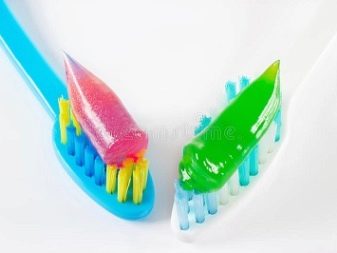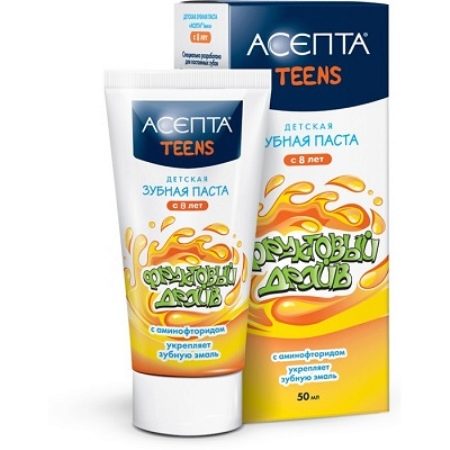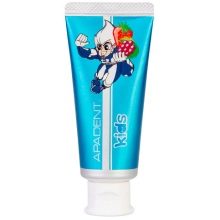Children's toothpastes

Healthy teeth of a child are not only a beautiful smile, fresh breath and calmness of parents, but also more important things. In childhood, the clarity of speech, the formation of cranial bones, the correct development of chewing processes, and facial aesthetics depend on proper care and timely treatment of teeth.
With all the variety of hygiene products, toothpaste remains the most common care method. Different formulations are suitable for specific conditions of tooth enamel, which is why it is so important to choose the right toothpaste.


How is it different from an adult?
Finding baby toothpaste on store shelves is quite simple - a bright tube, small size. But its content is much more important. The main difference between children's and adult pasta is the different concentration of the constituent components. Therefore, it is strictly forbidden for children under 14 years old to use adult pastes. The main goal of children's pastes is to prevent the development of caries, which often happens at this age. Also, the composition should contain components that help to gently transfer the process of changing teeth.
In pastes of this category, the amount of abrasive particles is either reduced or completely absent. This is due to the softer composition of the baby's tooth enamel. For example, the presence of calcium carbonate, sodium bicarbonate can significantly harm young teeth. It is better to replace them with titanium dioxide or silicon dioxide in the composition.
If you use a paste that is not so gentle, it will lead to increased sensitivity or destructive processes.


Such a danger can lie in wait for children's teeth even if aggressive whitening components get in. Therefore, it is so important not to allow your child to use your pasta.The saturation of the additives also differs in the two types of pastes. So, in the children's version, the presence of sodium fluoride is significantly reduced, while only in medicinal products. For ordinary children's pastes, this component is removed completely. Important components of baby paste are useful substances. The milk enzymes in the composition strengthen the child's immunity and increase the protective properties of saliva. This includes:
- glucose oxide;
- lactoferrin;
- lactoperoxidase;
- lysozyme.
The protein casein helps to strengthen the enamel with calcium. The natural component xylitol reduces the bacterial film and is responsible for the prevention of caries. And, of course, the most important difference for a child is the pleasant fruity taste of the toothpaste.


Types and compositions
Like adults, children's pastes are of two types - hygienic and therapeutic and prophylactic. Hygienic ones are responsible for cleansing and pleasant freshness from the mouth, they are not intended to treat the first signs of dental disease. This type of paste often contains food essences and essential oils, which give the paste a pleasant taste. This helps to easily accustom the child to daily routines.
Treatment-and-prophylactic pastes are supplemented with various dietary supplements:
- extracts of medicinal plants;
- enzymes;
- salts;
- vitamins.
Such types are used not only for everyday cleaning, but also to protect against caries, from plaque, to restore diseased gums, and prevent diseases of the oral mucosa.



Depending on the components, therapeutic and prophylactic pastes are of the following types.
- Vegetable. This type contains extracts of chamomile, sage, mint, myrtle, cloves and even spinach. These pastes are intended for the treatment of the oral mucosa, its regeneration, the cessation of bleeding gums and many inflammatory processes. They are often phytoncidal and support healthy oral flora.


- Saline. Such a remedy is saturated with mineral salts, which allows you to improve blood circulation in the gums, treat and even anesthetize them in case of inflammation. Salts also fight against the formation of pathogenic mucus and soft dental plaque, cleanse the enamel from bacteria, and nourish tissues.

- With enzymes. The enzymes in the composition do an excellent job of removing plaque from the enamel of the teeth, significantly improve the condition of the oral cavity.

- Anti-carious. They saturate the tooth tissues with minerals, serve to prevent plaque on the teeth. In the composition of such pastes, a compound of phosphorus, calcium and fluorine is used.



It often happens that babies do not spit, but swallow the paste. This is permissible in small quantities, because manufacturers pay special attention to the composition of children's products, especially for the category up to 6 years. Therefore, the most natural are pastes that can be swallowed.
Most baby toothpastes are hypoallergenic. But still, it is important for allergy babies to check indicators such as:
- fluorine content (it is better to choose organic fluorine - aminofluoride);
- the presence of herbal supplements (choosing pastes without mint and menthol should be people taking homeopathic medicines);
- concentration of flavors, dyes.


High abrasiveness is unacceptable in the content of baby paste. The enamel of babies is not strong enough to be tested with such strong substances, it is easy to damage it. Therefore, only adults can use whitening pastes. Often, a yellowish coating can be seen on the surface of a child's teeth, which darkens over time. This is a clear manifestation of tartar. For treatment, in this case, use special toothpastes with calcium and phosphorus, which will help get rid of the first signs of a stone.
Many experts agree that gel paste is the safest for children. It is distinguished by its natural composition and useful ingredients. The gel contains less harmful substances such as titanium dioxide and calcium carbonate. And also there are no abrasive particles dangerous for children's enamel.Such a remedy is not scary to swallow.
Manufacturers also come up with different types of pastes for girls and boys. They usually differ in tastes or fairy-tale characters that are depicted on the packaging.


Fluoride free
Almost all toothpastes contain fluoride. It is essential for the teeth. Fluoride helps to strengthen tooth enamel and fights against the appearance of pathogenic microflora in the oral cavity. The fact is that its compounds block the production of lactic acid by bacteria. And together with hydroxyapatite, fluorine forms a protective agent for enamel. But the excess content of this element in the body can cause fluorosis. This is a disease in which tooth enamel begins to change color. Also, oversaturation with fluorine negatively affects metabolism and blood clotting. Even in treatment-and-prophylactic pastes for children, the amount of fluoride is markedly reduced in comparison with adults.
Excessive consumption of fluoride can occur due to the fact that it is found in many foods and sometimes in drinking water. In some regions, water is fluoridated on purpose. Therefore, it is necessary to find out in advance if you belong to a region with a high fluoride content in the water, and then choose a safe paste for the child. When choosing a fluoride-free paste, you need to find an alternative way to protect your teeth from caries. For this, xylitol and calcium compounds are suitable. Manufacturers often use calcium lactate, calcium glycerophosphate, synthetic hydroxyapatite, calcium citrate, calcium pantothenate in the composition. Xylitol, on the other hand, fights the formation of lactic acid.
Fluoride-free pastes also use natural plant extracts to treat inflammation.


With calcium
This type of product is suitable for sensitive children's teeth. Calcium pastes have active remineralizing properties. For this, calcium compounds are used, which, upon contact with enamel, are embedded in the structure and restore it.

With aminofluoride
Aminofluoride (Olaflur) refers to organic fluorine compounds. Its properties make it possible to strengthen the tooth enamel with a protective film and prevent caries. Even a few hours after cleaning, the beneficial properties of this component continue to work. Today, it is this compound that is the best in the fight against tooth decay. It also stops the growth of plaque bacteria and desensitizes dental hard tissue.

With silver
The popularity of toothpastes with silver is now gaining momentum. Its medicinal properties have been applied in many areas since ancient times. Silver molecules are much smaller than bacteria and viruses. Therefore, it easily penetrates and destroys them. The tool uses very fine abrasive substances that have a mild whitening effect. It is this gentle property that allows the use of such a component in children's pastes.

With xylitol
In foods, xylitol is found in vegetables, fruits and berries. In pastes, xylitol not only destroys cariogenic bacteria, but also controls the pH balance of the oral cavity. Pathogenic microorganisms do not tolerate xylitol, therefore they die. Xylitol helps to assimilate useful minerals and can heal minor dental lesions. This substance is completely safe for young children.
Xylitol promotes healthy teething.

Top manufacturers
In the ratings of the best manufacturers of children's toothpastes, the following firms remain constant:
- Rocs;
- Splat;
- Lacalut;
- Japanese Apadent;
- Italian Biorepair;
- Swiss Elmex;
- German Weleda and Neobio.
The latter is especially popular among parents of babies up to 3 years old. Its natural composition without dyes or preservatives makes it edible if accidentally swallowed.



Korean manufacturers are also not lagging behind and present their options for daily and professional children's pastes. In the top of the most popular:
- Lion Kids Safe;
- «2080»;
- Median.
Oriental manufacturers - Japanese, Korean and Thai - pay special attention to the internal component.Manufacturers do not use artificial saccharin, only natural fruit fillings. In Thailand, for example, coconut, mint, and pineapple pastes are popular. They are also avoided in the composition of dyes, which makes their pastes hypoallergenic. Most often, products are presented in an economical gel texture.



Selection criteria
When choosing a baby paste, you need to focus on the age and current state of the baby's teeth. It is necessary to take into account the possibility of allergic reactions, the presence of caries and inflammation in the oral cavity. A doctor's recommendation and a study of the composition of the product will help you choose an excellent quality product. Graduation is carried out according to age categories.
- 0 - 2 years. In the first years of a child's life, toothpastes should be as natural as possible, preferably tasteless and edible. For infants, the composition must contain sufficient xylitol. A low percentage of abrasiveness is required for the milk teeth of one-year-old babies, so as not to damage the vulnerable enamel. Its indicator should not exceed 20 units. Also, a high concentration of fluorine (more than 500 ppm) is dangerous for them. Pastes made for children from 1 year old should contain extracts of medicinal plants.
- 36 years. By the age of 3-4, babies have a full set of milk teeth. The abrasiveness of the paste may slightly increase, up to 50 conventional units, the presence of fluorine is still not more than 500 ppm. At 5-6 years old, a smooth change of milk teeth to molars begins. Therefore, the product should provide a comfortable transition for the child, take care of protection from caries.
- 6 - 8 years old. At 6-7 years old, the replacement of milk teeth with molars continues, incisors and molars are cut through. Abrasiveness is still no more than 50, but you should not choose too low a number - the product should actively protect against plaque and caries. The fluorine content remains at the same level.
- For older people. In the period from 9 to 14 years, the replacement process is completed, and molars begin to prevail. It is advisable to control the cleaning process until the age of 10, since at this time the risk of caries increases. It is still dangerous to use adult toothpastes at the age of 11-12. The enamel is still delicate and easily damaged. The composition should contain mineralizing components, prevent inflammation of the gums. For teenagers, it is acceptable to increase the fluorine content to 1400 ppm, but not exceed the abrasiveness of more than 50 units.


How to use it correctly?
Dental care should start at a very early age. And do not rely on milk teeth, which will fall out along with the emerging caries. Severe damage to the milk tooth can negatively affect the formation and health of the permanent one. After all, the rudiments of the molar tooth are already located under the milk tooth.
- Until 1 year old, you do not need to use a toothbrush - a gauze swab will do. And at 1.5 years old, you can change it to a small brush.
- In the first months of life and up to 10 years, parents need to control the cleaning process, since this is the most crucial period for a future beautiful smile.
- Before the child himself takes up the brush, you need to accustom him to regular cleaning, carrying out hygienic procedures for his oral cavity in the morning and in the evening, observing a constant regime.
- At first, your personal example may interest the baby to repeat after the parents. To prevent the child from getting bored with the cleaning process, you can buy several toothbrushes or toothpastes and change them according to your mood.
- Doctors advise be sure to time the cleaning. It should be at least 2 minutes. You can use an hourglass and arrange with your child to brush their teeth while the sand is pouring.
- To preserve the protective layer of fluoride, it is best to spit out the paste after cleaning, but do not rinse your mouth with water.











